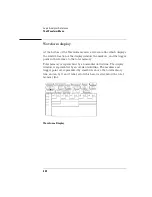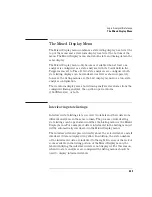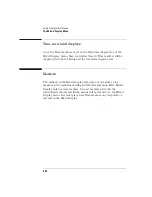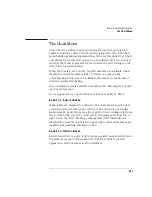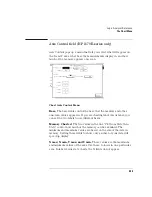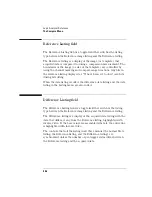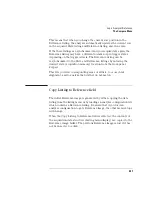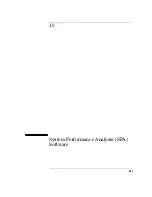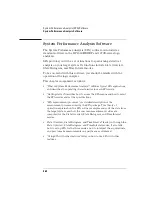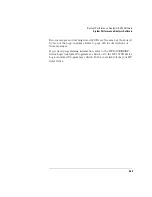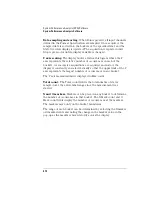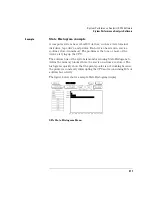
362
System Performance Analysis (SPA) Software
System Performance Analysis Software
System Performance Analysis Software
The System Performance Analysis (SPA) software is included as
standard software in the HP 1660E/ES/EP and 1670E-series logic
analyzers.
SPA provides you with a set of functions for performing statistical
analysis on your target system. Its functions include State Overview,
State Histogram, and Time Interval modes.
To be successful with this software, you should be familiar with the
operation of the logic analyzer.
This chapter is organized as follows:
•
"What is System Performance Analysis?" outlines typical SPA applications,
and describes the operating characteristics for each SPA mode.
•
"Getting started" describes how to access the SPA menus and how to select
the SPA modes and set the specifications.
•
"SPA measurement processes" is a detailed description of the
measurement processes used by the SPA package. This theory of
operation explains how the SPA software samples and sorts the data from
the target system, and how the onscreen measurement values are
computed for the State Overview, State Histogram, and Time Interval
modes.
•
State Overview, State Histogram, and Time Interval" leads you through the
State Overview, State Histogram, and Time Interval modes. It also tells
how to set up SPA for the three modes, how to interpret the acquired data,
and how to make measurements on specific areas of interest.
•
"Using SPA with other features" tells you how to use SPA with other
features.
Summary of Contents for 1670E Series
Page 6: ...6 In This Book...
Page 26: ...26 Contents...
Page 27: ...27 Section 1 Logic Analyzer...
Page 28: ...28...
Page 29: ...29 1 Logic Analyzer Overview...
Page 39: ...39 2 Connecting Peripherals...
Page 49: ...49 3 Using the Logic Analyzer...
Page 72: ...72 Using the Logic Analyzer The Inverse Assembler...
Page 73: ...73 4 Using the Trigger Menu...
Page 101: ...101 5 Using the Oscilloscope...
Page 151: ...151 6 Using the Pattern Generator...
Page 199: ...199 7 Triggering Examples...
Page 237: ...237 8 File Management...
Page 249: ...249 9 Logic Analyzer Reference...
Page 360: ...360 Logic Analyzer Reference The Compare Menu...
Page 361: ...361 10 System Performance Analysis SPA Software...
Page 397: ...397 11 Logic Analyzer Concepts...
Page 430: ...430 Logic Analyzer Concepts The Analyzer Hardware Oscilloscope board theory Oscilloscope board...
Page 439: ...439 12 Troubleshooting the Logic Analyzer...
Page 455: ...455 13 Specifications...
Page 471: ...471 14 Operator s Service...
Page 479: ...479 Operator s Service Troubleshooting Troubleshooting Flowchart 2...
Page 491: ...491 Section 2 LAN...
Page 492: ...492...
Page 493: ...493 15 Introducing the LAN Interface...
Page 497: ...497 16 Connecting and Configuring the LAN...
Page 506: ...506 Connecting and Configuring the LAN Connecting and Configuring the LAN...
Page 507: ...507 17 Accessing the Logic Analyzer File System Using the LAN...
Page 515: ...515 18 Using the LAN s X Window Interface...
Page 527: ...527 19 Retrieving and Restoring Data Using the LAN...
Page 539: ...539 20 Programming the Logic Analyzer Using the LAN...
Page 546: ...546 Programming the Logic Analyzer Using the LAN Programming the Logic Analyzer Using the LAN...
Page 547: ...547 21 LAN Concepts...
Page 555: ...555 22 Troubleshooting the LAN Connection...
Page 580: ...580 Troubleshooting the LAN Connection Getting Service Support...
Page 581: ...581 Section 3 Symbol Utility...
Page 582: ...582...
Page 583: ...583 23 Symbol Utility Introduction...
Page 588: ...588 Symbol Utility Introduction Symbol Utility Introduction...
Page 589: ...589 24 Getting Started with the Symbol Utility...
Page 597: ...597 25 Using the Symbol Utility...
Page 609: ...609 26 Symbol Utility Features and Functions...

